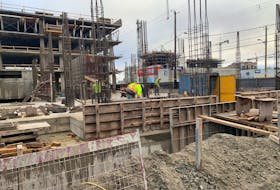EAST HANTS, NS - Nova Scotia’s aging population presents a variety of issues, and increased healthcare costs and a shrinking labour force are the two big ones.
It’s an issue that is virtually universal across the entire province — except for one region.
East Hants is the only jurisdiction in Nova Scotia that has more young people (aged infant to 14) than seniors (65+), according to a recent socio-economic study backed up by numbers via Statistics Canada.
With 23,542 residents, East Hants, including Indian Brook, has 3,915 people under 15 years of age, representing 17.5 per cent of the population. There are 3,450 people over the age of 65, representing 15.4 per cent.
For comparison sake, in Kings County, infants to 14-year-olds make up 15 per cent of the population, while 65 and older makes up 21 per cent.
East Hants even beats out HRM, Nova Scotia’s most populated municipality, which has 15 per cent infant to 14-year-olds and 15.7 per cent of people who are 65 and over.
It’s good news for the government of East Hants, as it shows that more young couples are deciding to put down roots and raise families there.
John Woodford is the director of planning and development with the Municipality of East Hants, which put out the study earlier this year.
“East Hants is one of the few municipalities in Nova Scotia that is growing,” Woodford said. “The biggest driver of that is what we call the corridor area, places like Enfield, Elmsdale and Lantz. Since the last census period, that area grew 14.6 per cent, which is quite high for Nova Scotia.”
A lot of that growth is thanks to the proximity of Halifax and the Halifax Stanfield International Airport.
The municipality is also expecting to see a spike in population over the next 10-20 years, with most of that boom taking place in the corridor region. No municipality outside of HRM grew more between 2011 and 2016 than East Hants at 1.5 per cent.
The Mount Uniacke/Rawdon area in East Hants is also expected to see a boost in population, although not as substantial as the corridor region.
But this boom isn’t universal. Central and shoreline East Hants, which includes the communities of Noel and Kennetcook, is projected to see a decline in population, if demographic trends continue.
In essence, the data shows that the closer to Halifax the community is located, the higher the potential for population growth.
The socio-economic study covers more than just demographics — it also breaks down things like household income, education levels, health and development activity. According to the study, East Hants has a median household income of $72,898, well above the $60,764 average for Nova Scotia.
However, most residents are commuting outside of the municipality to obtain that income — 69.5 per cent commute outside of East Hants for work — compared to only 27 per cent of other Nova Scotians. Most of those East Hants commuters are traveling to either HRM or Colchester County, making East Hants primarily a ‘bedroom community,’ where residents live in an area but work elsewhere.
“We are within commuting distance to Halifax, which has led to our population growth, but it’s also lead to a very mobile labour force,” Woodford said. “We have looked at transit, most recently three years ago, and there is a business case for it. It’s not particularly strong right now, but we are going to continue to look at it as the population continues to grow.”
Woodford said another interchange on Highway 102, near Lantz, will help enhance commuting efficiency for residents along the corridor. That work is expected to be completed in the next few years.
“A key focus for us is to get additional commercial growth in the municipality,” he said. “The amount of residential assessment we have versus commercial is quite high. We’re making a number of efforts to increase that.”
The primary form of employment in East Hants is trades, transport and equipment operators and related fields, with 23.1 per cent of workers employed in those areas.
Meet the young people of East Hants – and the parents who are raising them
Where are they living?
The vast majority of East Hants residents, 83 per cent, are living in single-detached homes.
An additional 5.3 per cent live in movable dwellings, 5.2 per cent reside in apartments (less than five storeys), 3.7 per cent live in semi-detached houses. Only 1.6 per cent live in a flat or duplex apartment and 1.3 per cent call row houses home.
In comparison, only 65.7 per cent of Nova Scotians live in single-detached houses.
Residential growth continues to be the primary source of development in East Hants, with home construction representing 86 per cent of development between 2012 and 2016. Commercial, agriculture and institutional development represented the remaining 14 per cent.
Between 1988 and 2016, an average of 155 new homes were constructed each year, with the majority built in the corridor region.
“Ten years ago, there wasn’t a single townhouse in East Hants, and now quite a number of our multi-unit builds are townhouses, as well as apartment buildings,” Woodford said. “We expect that trend to continue. Although our population is younger than the rest of the province, it is still aging, and more housing options are seen as needed for a wider variety of people.”
In 2016, there were more apartment builds than single-detached home starts, representing a major change in the style of housing being built.
“It appears that we’re well situated for this level of growth. We upgraded a number of our systems over the last number of years,” he said. “Our water treatment plant in Enfield expanded, our transmission system is being expanded and the sewage treatment plant in Milford is relatively new.
Residential assessments make up 84.5 per cent of the total taxable assessment value for the municipality, with commercial assessments comprising 7.9 per cent.
One of the challenges of this younger, growing population is the need for more services, and the municipality is investing heavily to keep people happy.
“We’re about to break ground on a new aquatic centre, and it’s one of our biggest investments ever,” he said. “There is a demand here for recreation services as a result of a growing population and a younger population, so we are building that facility, as well as stepping up our efforts with open space facilities.”
The aquatic centre is expected to cost $19 million, with the Government of Canada contributing $5.8 million and the Municipality of East Hants providing $13.2 million.
“People do ask about those services; they’re important in attracting people,” Woodford added.

Mount Uniacke
Mount Uniacke Coun. Cyril McDonald says the level of growth in the municipality stands out the most for him in the study.
“If you look at the growth here, compared to other municipalities across the province, we are one of the few that continues to grow in a positive direction,” McDonald said. “The increase of youth in the community is also a very advantageous.”
He points to a Mount Uniacke business park that’s been sold out for several years, saying council has struggled to identify land to grow in that capacity.
One of the things that makes East Hants so appealing to residents and business owners is the relative low cost of land and the low tax rate.
Mount Uniacke currently isn’t served by water or septic, but McDonald said some people prefer that.
“We’re a bedroom community, we border on Sackville, we border on Hammonds Plains, we border on Windsor,” he said. “We get the luxury of being near those services and amenities without paying for them.”
McDonald said the nearby Forest Lakes development in West Hants will also be a huge benefit to Mount Uniacke and surrounding communities once things ramp up.
“It’s going to spread to East Hants,” he said. “A major golf course in there, shopping in there — those are great amenities to have.”
With approximately 70 per cent of residents commuting outside of East Hants, McDonald said transit is too expensive an option for the municipality to pursue alone. He believes the province should make it more of a priority.
“The population is relatively small; a rider service coming through that area is something that could be investigated, and it has been,” he said. “But more so for the corridor area. We have invested a lot of money looking at bridging Metro Transit and other opportunities to see what we could provide, but the cost is high.”
He believes other priorities should be higher, like high speed internet, which wasn’t addressed in the study. The lack of high speed internet will be one of the largest issues for the municipality to deal with in the next 20 years.
“If you don’t have high speed internet in your home today, it’s the same as being without electricity in the 1970s, 1980s, there’s no other comparison,” he said. “If the provincial government doesn’t take a stand today, we’ll never catch up.”









